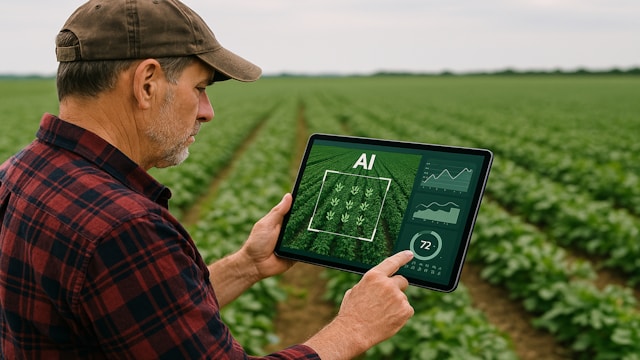Farmers today face greater challenges than ever before. From unpredictable weather caused by climate change to rising costs of resources and the demand to feed a growing global population, agriculture is under pressure to become smarter and more efficient. This is where artificial intelligence is making a significant difference. By introducing data-driven insights, predictive modeling, and smart farming technology, AI is transforming how farmers grow crops. Instead of relying only on traditional methods, modern farmers are adopting AI in agriculture to improve productivity, save resources, and create a more sustainable future for food production.
The Role of AI in Agriculture
At its core, AI in agriculture helps farmers make better decisions. Traditional farming often depends on experience, observation, and manual labor, but AI allows farmers to process vast amounts of data in real time. From analyzing soil conditions to predicting weather patterns, AI-powered systems deliver insights that are impossible to gather manually. This combination of precision agriculture and machine learning is allowing farmers to grow more with less boosting yields while reducing costs and environmental impact.
AI Applications in Farming
Crop Monitoring and Disease Detection
One of the most promising uses of AI farming tools is crop monitoring. Drones, sensors, and satellite imagery powered by AI can scan large fields to detect signs of pests, diseases, or nutrient deficiencies long before the human eye can see them. For example, AI image recognition software can identify leaf discoloration and alert farmers to potential crop diseases. This enables early intervention, preventing widespread damage and saving both time and money.
Precision Agriculture
Smart farming technology driven by AI allows farmers to apply fertilizers, pesticides, and water only where they are needed. Sensors collect data on soil health and moisture, and AI systems analyze this information to determine the exact amount of input required. Instead of spraying entire fields, farmers can now target specific areas. This reduces waste, lowers costs, and helps protect the environment by minimizing chemical use.
Yield Prediction and Crop Planning
AI crop management systems can forecast yields with remarkable accuracy by analyzing weather data, soil quality, and historical harvests. These predictions help farmers decide what crops to plant, when to plant them, and how to allocate resources. With climate patterns becoming less predictable, this ability to anticipate outcomes is becoming a vital tool for agricultural planning.
Automated Machinery
AI-powered tractors, harvesters, and planting robots are revolutionizing farm labor. These machines can work around the clock, planting seeds with precision, removing weeds, and harvesting crops without fatigue. By reducing reliance on manual labor, automated machinery helps farmers cut costs and keep operations running smoothly, even when labor shortages occur.
Supply Chain and Market Forecasting
AI doesn’t just help with planting and harvesting it also plays a role in selling crops. Predictive analytics can estimate market demand, allowing farmers to sell their produce at the best time for maximum profit. By forecasting supply chain needs, AI helps reduce food waste and ensures crops reach consumers efficiently.
Benefits of AI for Farmers
The integration of AI in agriculture offers numerous advantages:
-
Higher crop yields: By optimizing planting and monitoring conditions, AI ensures maximum productivity.
-
Reduced costs: Precision agriculture reduces unnecessary spending on water, fertilizers, and pesticides.
-
Sustainable practices: Smart farming technology minimizes environmental impact by conserving resources.
-
Climate resilience: AI farming tools help farmers adapt to changing weather patterns with predictive insights.
-
Better decision-making: Data-driven recommendations reduce guesswork and improve long-term strategies.
Challenges and Limitations
Despite its promise, farming with AI is not without challenges. High costs of advanced equipment and AI farming tools can make adoption difficult for small farmers. Rural areas may also lack the digital infrastructure needed for AI-based solutions. Additionally, farmers need training to effectively use these systems, as not everyone is familiar with advanced technology. Overcoming these barriers will require support from governments, agri-tech companies, and educational programs.
Future of Smart Farming with AI
The future of precision agriculture looks promising as AI continues to evolve. Upcoming innovations include fully autonomous farms, AI systems that adapt to climate change, and robotics capable of performing delicate tasks like fruit picking. Virtual assistants for farmers may soon become common, offering real-time recommendations through smartphones. With governments and agricultural technology companies investing heavily in smart farming solutions, AI will likely become accessible to more farmers worldwide, leading to a more sustainable and efficient global food system.
Conclusion
Artificial intelligence is reshaping agriculture by giving farmers the tools they need to face modern challenges. From crop monitoring to market forecasting, AI in agriculture is improving efficiency, sustainability, and profitability. Far from replacing farmers, smart farming technology empowers them to make better decisions and achieve higher yields with fewer resources. As the world looks toward feeding billions more people in the coming decades, farming with AI will play a central role in ensuring a secure and sustainable food future.

